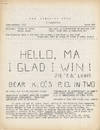
A New Terrestrial Globe J. Newton 1783.: Newton's first pocket globe
by NEWTON, J[ohn]
- Used
- Condition
- See description
- Seller
-
London, United Kingdom
Payment Methods Accepted
About This Item
London,, 1783.. Diameter: 70mm (2.75 inches).. Globe, 12 hand-coloured engraved paper gores, clipped at 65 degrees latitude, with two polar calottes, over a papier mâché and plaster sphere, varnished, housed within original shagreen over paste-board clamshell case, with hooks and eyes, lined with 12 hand-coloured engraved celestial gores, with two polar calottes, varnished. The case split in both halves where hinge would have been, loss to exterior and minor loss to celestial gores. Biography During the first half of the nineteenth century the firm of Newton, together with Bardin and Cary, occupied a leading position in the manufacture of globes in London. The firm was established by John Newton in 1783 and operated originally from the Globe & Sun 128 Chancery Lane, moving to 97 Chancery Lane in 1803, before settling at 66 Chancery Lane in 1817. John Newton (1759-1844) was trained by Thomas Bateman (fl1754-81), who had previously been apprenticed to Nathaniel Hill (fl1746-1768). Newton's first globe was a revised edition of Hill's 1754 pocket globe, which he published in 1783 in association with William Palmer. The partnership dissolved shortly after, and Newton continued to publish the pocket globe under his own name. John's second son William Newton (1786-1861) joined the firm between 1814-1816, which traded under the name J. & W. Newton. In the same year the firm produced a new series of globes, including a new pocket globe. By the 1830s the firm was also active as a patent agent and was joined by Miles Berry, a civil engineer and patent agent, after which the firm was known as Newton, Berry & Son. In 1842, William's eldest son, William Edward Newton (1818-1879), joined the business, followed by his brother Alfred Vincent Newton (1821-1900). The firm became known as W. Newton & Son, or once again, on the death of William, as simply Newton & Son from 1861 until about 1883. Perhaps the greatest triumph for the Newton family was the Great Exhibition of 1851, where, aside from the globes they exhibited from 150 to 635mm (1 to 25 inches) in diameter, they were awarded a prize medal for a manuscript terrestrial globe of six feet in diameter. Geography Newton used Hill's copper plates from his 1754 pocket globe for the present globe with a number of alternations and updates. He has changed the text within the cartouche to feature his own name, however he retains the rococo cartouche that Hill used. Newton added Captain Cook's track and updated the Australian coastline with his discoveries, including "New Holland", "New South Wales", "Botany Bay", "Dimens Land", "Lewins L[and]", the "I[sles of ] St Francis" and "New Zeeland". The globe shows the equinoctial graduated in degrees, and the conforming ecliptic is highlighted in green. The prime meridian passes through London, and the principal land masses are outlined in colour and annotated with some of the major rivers and mountain ranges. The oceans show the winds with islands labelled and printed with dotted lines for Admiral Anson's Tract and the tract of Captain Cook's first voyage in 1760, while, the North Pacific region features a rococo scroll title cartouche. Astronomy The gores are pasted to the inside of the case, and the cartography features stars expressed in varying orders of magnitude and allegorical representations of the constellations finely executed. Dekker GLB0029; Dekker and van der Krogt, fig.57; for reference see Dahl and Gauvin, pp.93-95; van der Krogt, Hil 1 and Hil 4; Worms and Baynton-Williams, pp.318-319; Dekker, pp.355-357.
Reviews
(Log in or Create an Account first!)
Details
- Bookseller
- Daniel Crouch Rare Books Ltd
(GB)
- Bookseller's Inventory #
- 14487
- Title
- A New Terrestrial Globe J. Newton 1783.
- Author
- NEWTON, J[ohn]
- Book Condition
- Used
- Place of Publication
- London,
- Date Published
- 1783.
- Keywords
- Hill, pocket globe, rare globe, antique globe, instrument
- Product_type
- Instruments
- Size
- Diameter: 70mm (2.75 inches).
Terms of Sale
Daniel Crouch Rare Books Ltd
Any item may be returned if you are not happy with it providing we are notified within 7 days of your receiving it. This does not affect any statutory rights you may have under UK or EU law for returning the item outside this period. All we ask is that you return the item(s) by the same or similar method to that in which they were sent to you. Your postage costs and any payment already received will be refunded immediately on our receipt of the items in the same condition as you received them.
About the Seller
Daniel Crouch Rare Books Ltd
Biblio member since 2018
London
About Daniel Crouch Rare Books Ltd
Daniel Crouch Rare Books is specialist dealer in antique atlases, maps, plans, sea charts and voyages dating from the fifteenth to the nineteenth centuries. Our carefully selected stock also includes a number of fine prints and globes, and a selection of cartographic reference books.Our particular passions include rare atlases, wall maps, and separately published maps and charts. We strive to acquire unusual and quirky maps that are in fine condition. We are members of the following trade associations: The Antiquarian Bookseller's Association (ABA); The British Antique Dealers' Association (BADA); Confédération Internationale des Négociantes en Oeuvres d'Art (CINOA); The International League of Antiquarian Booksellers (ILAB); The Society of London Art Dealers (SLAD); and The European Fine Art Foundation (TEFAF). Daniel and Nick are also both members of The Company of Art Scholars, Dealers, and Collectors.





